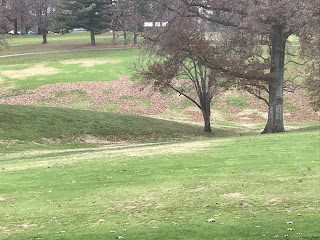Currently, leaf removal has been absorbing most of the grounds department's time. The many pin oak trees located throughout the golf course (because of
marcescent foliage) are slowly letting go of their leaves. The wind storm that blew through around Thanksgiving helped to fall much of the foliage; however there are a couple trees still unloading. Hopefully we are on our final blow/chop operation and will be able to move on to other projects shortly.
 |
| An abundant amount of oak leaves after the pre-Thanksgiving day wind storm |
One important winter project on the horizon is tree/branch removals. In October we conducted a tree evaluation to address any diseased or dying trees. A few of our oak trees are becoming infected with
Ganoderma-an aggressive wood rotting fungal infection that decays heartwood and can move into vascular layers. Large abrasions are a common entry point and once a tree is infected there is no cure. One of the first noticeable signs of infection is the presence of a conk (mushroom growth) growing on the trunk. This combined with significant canopy dieback indicates a severe infection and is recommended for immediate removal. Another common malady is co-dominant trunks with included bark. Large pin oaks with this have a high failure rate because of the massive amount of pressure put on the intersecting point. The lower the co-dominate trunk branches begin the more dangerous the situation. Also, many of the Colorado blue spruce trees are becoming infected with
rhizosphaera needle cast disease and/or
cytospora canker disease and are quickly deteriorating. Not to mention the e
merald ash borer and all the damage that has caused to the ash trees.
 |
| Red conk indicating a Ganoderma infection on a red oak |
 |
| White sap coming from an infection point indicating cytospora canker disease on a blue spruce. |
 |
| Rhizophaera needle cast disease on blue spruce trees indicated by dieback of lower branches progressing upward. |
 |
| Co-dominant trunk with included bark on pin oak by #8 tee |
|
|
Dying ash tree courtesy of the emerald ash borer.
|
The grounds department has a certified arborist on staff and consults with a board-certified master arborist once every two or three years to ensure that the WHCC trees are reasonably safe and in good health. Some healthy trees are in consideration for removal only if they are negatively impacting high priority turf areas
(click here for more information about trees and turf). Some of these trees were recommended for removal by the USGA agronomist during his visit in May. All potentially removed trees are discussed with the greens committee before any removals take place.
 |
| 2019-2020 winter tree removals |
Outside of tree work there have been other projects that the grounds team has been accomplishing. One was the blow out of the irrigation system in early December. This is a necessity to eliminate the possibility of pipes freezing and cracking during the winter months. This was accomplished by hooking up an air compressor to our pump station and then blowing out each individual head on the course and winterizing the pump station. Other projects included: leveling out of the bumpy area at the bottom of #15 fairway, completing the late fall fertilization, finishing the tulip bulb plantings, and continuing to mow on an as needed basis.
 |
| Irrigation blow-out |
 |
| Leveling of #15 fairway area |
As we move deeper into winter, tree work will take center stage along with parking lot snow removal, attending turf/horticulture seminars, new landscape designs, staff recruitment, equipment maintenance, creating maintenance standards and a 2020 maintenance calendar, bunker work, and the upkeep of appurtenances. The grounds department is thankful for a great 2019 season and we look forward to an even better 2020 season. We wish everyone a Merry Christmas and Happy New Year!
Brad Piecuch
Assistant Superintendent








